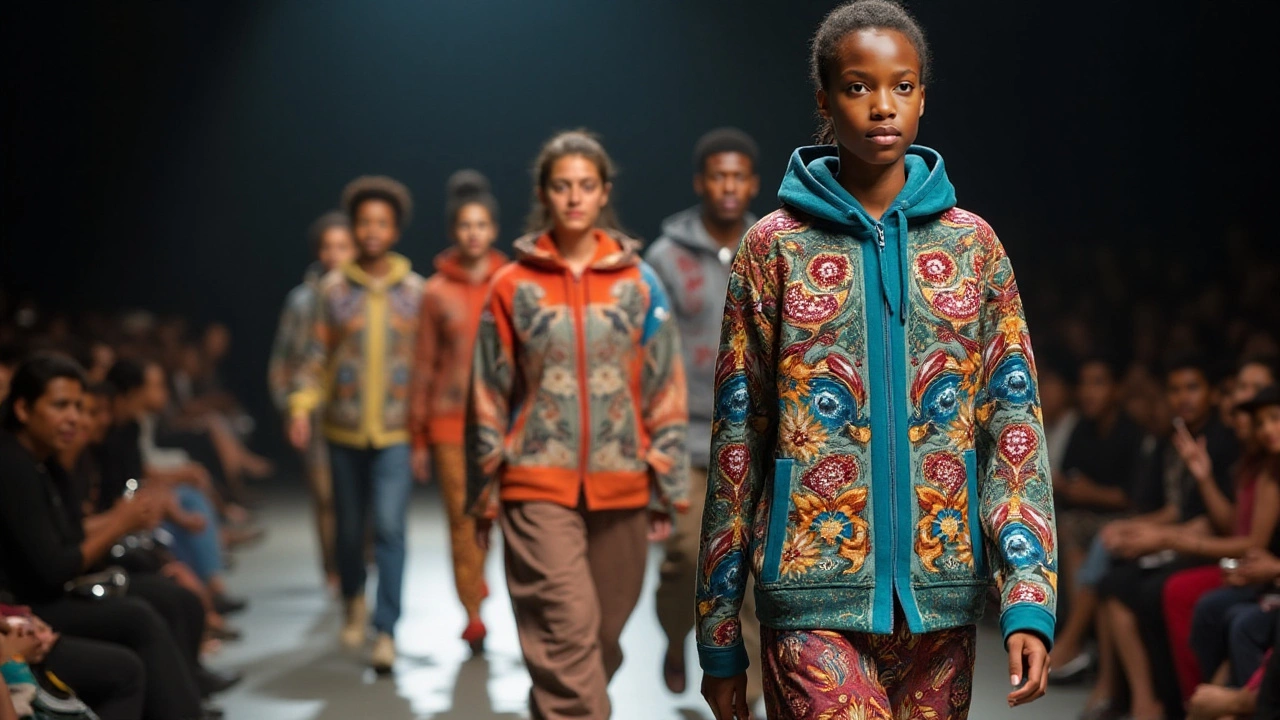The Symbolism of Hoodies in Modern Fashion and Culture

Hoodies, those cozy garments we often reach for on chilly days, have an intriguing story woven into their fabric. Far from being just an item of apparel, hoodies have evolved into cultural icons, representing a myriad of meanings across different groups. Their journey through the realms of fashion and society reflects complex narratives of identity, resistance, and belonging.
Once just a staple for athletes and construction workers, the hoodie has transcended its utilitarian roots. Today, it graces high fashion runways, serves as a canvas for street artists, and sparks dialogues about individuality and rebellion. So why has this simple piece of clothing become such a potent symbol in modern times? By diving into its history, cultural significance, and current role in fashion, we can uncover the layers of meaning embedded in hoodies.
- Historical Origins
- The Hoodie in Popular Culture
- A Symbol of Rebellion
- Fashion Meets Functionality
- The Hoodie as Personal Expression
- The Future of Hoodies
Historical Origins
To truly understand the cultural significance of hoodies, it's important to travel back to their humble beginnings. Hoodies, as we know them today, trace their roots to the early 1930s in the United States. Designed by the sportswear company Champion, hooded sweatshirts were initially intended to provide warmth to workers in cold warehouses in upstate New York. With their thick fabric and practical hoods, these garments were utilitarian, offering protection from harsh weather and inevitably becoming an instant hit among laborers who needed warmth and comfort.
The idea of adding a hood was not entirely novel. Medieval monks had worn hooded habits, and such garments can even be traced back to ancient Greece, where cloaks called ‘pilos’ featured hoods. Hoodies also draw influence from the 'hooded tunics' worn by commoners in medieval Europe. Such design elements have transcended time, showing how practical needs can give rise to iconic fashion pieces. By the 1970s, hoodies began to leap from utilitarian attire to pop culture phenomena; a transition largely spurred by their adoption among athletes and later by hip-hop culture.
During the 1970s and 1980s, the hoodie emerged as a symbol of the burgeoning hip-hop culture in New York City. This association brought a new layer of cultural significance. It was not merely about warmth or comfort anymore. It became a badge of identity, unity, and sometimes, defiance against the status quo. As graffiti artists and breakdancers donned hoodies, this garment began to symbolize a deeper code of the streets. And who can overlook the influence of films like "Rocky," where Sylvester Stallone's iconic training montage in a hoodie crystallized its association with grit and determination?
Consider this insight from fashion historian Patricia Cunningham:
“The evolution of the hoodie from practical workwear to a counter-cultural icon is a testament to its adaptability and universality. It highlights how a single garment could occupy such diverse spaces within society, evolving with the times yet retaining its core essence.”Sports also played a crucial role during this period. The hoodie became a staple in locker rooms across the United States, embraced by college athletes and their fans alike. With educational institutions emblazoning their logos and names across hoodies, they transformed into symbols of school pride and communal spirit.
The turn of the millennium witnessed the hoodie evolving further in its meaning and reach. As it became part of skateboarding culture, it was embraced by icons who defined that era's rebellious wave. The juxtaposition of style versus substance, fashion versus function, helped the hoodie cement its place in modern wardrobes. Today, with sustainability becoming a buzzword, many fashion brands explore organic materials and ethical production processes to meet consumer demands, yet another evolution fitting the hoodie’s long-standing narrative. Such adaptability ensures its continuous circulation within cultural and fashion spheres, reflecting an amalgam of its past and present incarnations.
The Hoodie in Popular Culture
In recent decades, the humble hoodie has made its way into the heart of pop culture, a testament to its adaptability and enduring appeal. From movie screens to music videos, this garment has been embraced by celebrities and artists who use it to craft their public personas. Take the '80s cult classic 'Rocky', where the hoodie was immortalized as a symbol of grit and determination. It’s not just about keeping warm; it’s a piece that tells a story, offering hints about the wearer's state of mind or societal stance.
Pop culture icons like Kanye West and Rihanna have not only worn hoodies but have also incorporated them into their fashion lines, transforming them into luxury items. Such moves blur the lines between streetwear and high fashion, allowing hoodies to seep into different style realms. In street culture, they are often linked to hip-hop, a genre that thrives on expressing rebellion and raw honesty. This connection amplifies the hoodie’s significance, making it a badge of identity for many artists.
There's an undeniable allure to the mystery a hoodie can provide. Films often use them to characterize individuals who live on the fringes, from anonymity-seeking hackers to misunderstood outsiders, adding layers to the narrative the garment narrates. In one memorable scene from the series 'Mr. Robot', the protagonist, a skilled hacker, dons a hoodie, cementing its association with subversion and the fight against faceless power.
"The hoodie is a powerful concealment device. It's not just about the climate but about privacy and protection—not just from the physical world, but from societal expectations," remarked fashion theorist, Dr. Patricia Brown.
When it comes to data, the market size of streetwear, inclusive of hoodies, has seen exponential growth. According to a report from Statista, by 2023, the global streetwear market was valued at over 309 billion dollars, showcasing how deeply ingrained these garments are in everyday fashion consciousness. Hoodies, therefore, aren't merely a trend but an enduring symbol of cultural expression across generations. Their presence in pop culture continues to evolve, supporting the narrative of inclusion and transformation that they have long represented.

A Symbol of Rebellion
The hoodie has traveled a fascinating path to become an emblem of rebellion and counterculture. Its journey begins in the 1930s with humble origins as functional workwear. By the 1970s and 80s, it found its place among subcultures like hip-hop and punk, capturing the spirit of nonconformity. Its oversized, often dark appearance became a form of silent protest against societal norms. But why is it that a simple garment, a sweatshirt with a hood, has such strong ties to ideas of rebellion?
Part of the answer lies in its ability to obscure identity. When you pull up that hood, you create a barrier between yourself and the world, and this anonymity can be powerful. In urban environments, especially, the hoodie became a sort of uniform for those who felt marginalized or overlooked. It let them blend in but also stand apart, a paradoxical statement that resonated deeply. This symbolism was not lost on the media, who sometimes painted the hoodie as menacing or threatening. But for those who wore it, it was a shield against judgment and stereotype.
In modern times, we saw its connection to civil rights movements, where individuals donned hoodies to express solidarity and resistance. One poignant example was the "Million Hoodie March" following the tragic death of Trayvon Martin in 2012. People all over wore hoodies to signify unity and demand justice, highlighting the garment's potent symbolic power. It was no longer just a piece of clothing but a mobile canvas for change and awareness. As cultural commentator Jay Carney once remarked,
"A hoodie is more than just a sweatshirt; it's a statement, a silent protest, and a shield all rolled into one."Even today, when protestors gather, the hoodie is often part of their attire.
The symbolism of rebellion associated with hoodies is also depicted in cinema and music. Films like "Rocky" and "Straight Outta Compton" showcase the hoodie as an essential element of a rebel's wardrobe, further solidifying its place in pop culture as a garment worn by those who defy authority. Musicians, from rappers to punk bands, embrace it as a statement piece, amplifying its rebellious connotations. It's interesting how something so simple can carry so much weight—a testament to the shifting attitudes towards identity and self-expression.
However, it's not merely about appearing defiant. The hoodie represents a refusal to conform, a desire to question the status quo and seek social justice. It has become a tool of empowerment, enabling individuals to confront and challenge societal norms. Whether worn by skaters in alleyways or by fashion-forward individuals on the runway, its rebellious spirit remains intact. The hoodie is not just a garment but a testament to the undying spirit of those who dare to question, resist, and redefine the world around them.
Fashion Meets Functionality
Fashion, at its core, is about expression, but it also caters to the practical needs of those who embrace it. The hoodie stands as a perfect embodiment of this fashion-functionality balance. Initially designed to shield athletes from the elements, it now serves countless purposes. The attachment of a hood, for instance, is its standout feature – effortlessly combining form and function. This simple addition has made hoodies versatile favorites in environments ranging from city streets to university campuses. A closer look reveals why they've become indispensable: they provide warmth and protection while maintaining a stylish edge.
Hoodies are prominent in outdoor wear collections due to these practical elements. Their ability to merge seamlessly into urban fashion scenes while offering weather protection illustrates their unique adaptability. The fabric choices, including fleece-lined, cotton, and even waterproof materials, appeal to diverse climates, from rainy days in London to sunny-but-chilly afternoons in San Francisco. The evolution in design includes features such as kangaroo pockets, providing more than just hand warmth – they keep essentials like phones and wallets secure. Some versions even include built-in earbud holes or internal compartments for tech gadgets, reflecting society’s increasing tech dependence. Such thoughtful additions emphasize the hoodie’s central role in our daily lives.
Notably, the hoodie has piqued the interest of high-fashion designers. Brands like Balenciaga and Vetements have taken the hoodie from streets to high fashion, reimagining it with silhouettes and textures that uplift it from its casual origins. Fashion-leaning citizens have welcomed these interpretations, blending them into their professional wardrobes in innovative ways – a sign of the hoodie’s versatile nature. It's becoming a norm to spot a pristine oversized hoodie paired with tailored pants and stiletto boots, making a statement about blurred lines between comfort and professional attire.
"Hoodies reflect our generation’s pivot towards comfort without sacrificing individuality," claims fashion critic Alex Millstone, analyzing this trend's cultural implications. "It symbolizes a move away from rigid formal wear to a more personalized, relaxed expression."
Beyond style, the hoodie’s functionality is celebrated among cyclists and urban explorers who relish its layered convenience. In colder months, it morphs into a mid-layer, combining with jackets for optimal warmth. Meanwhile, nurse practitioners, teachers, and freelancers favor them due to their enduring comfort during long work hours. This utility is further underscored by statistics showing that more than 80% of young adults own several hoodies, incorporating them into various facets of their lives. It's clear that the hoodie isn't just about style or function—it's about lifestyle.

The Hoodie as Personal Expression
The hoodie has come to represent a canvas upon which individuals paint their unique identities, merging fashion with personal narrative. It often starts as an unobtrusive piece of clothing but quickly embodies so much more. People looking to make a statement frequently choose hoodies to communicate aspects of their personality and beliefs. Customization enables wearers to be their own designers, whether opting for bold prints, subtle insignias, or texture-rich fabrics. The act of wearing a hoodie can signify an allegiance to a particular community, effectively blurring the lines between clothing and communication.
What makes the hoodie such a potent vehicle for personal expression is its versatility. It's a garment that transcends age, gender, and socioeconomic boundaries, lending itself to various interpretations. For some, it's a declaration of non-conformity, while others use it as a shield, a way to seek comfort and privacy in a bustling world. The hoodie can articulate everything from sports passions to subcultural affiliations, creating an intricate tapestry of identity that individuals weave into their daily lives.
"The hoodie is a blank slate. It offers people a unique opportunity to convey their message without uttering a word," explained renowned fashion historian Penny Martin. "Its place in our wardrobe reflects an innate desire for expression."
Social movements have appropriated hoodies as symbols of solidarity and support, making them synonymous with resistance and social commentary. An iconic example is the 2012 case in the United States, where hoodies became a symbol of protest and unity, highlighting issues of racial injustice. This pivotal moment showcased how an article of clothing could amplify societal discourse. Such instances underline how a seemingly ordinary garment can serve as a powerful medium for socio-political expression and incite tangible cultural change.
Several brands have tapped into this desire for self-expression, offering personalized hoodies that cater to niche markets. Companies promoting sustainable fashion might design hoodies using eco-friendly materials, targeting conscious consumers. At the same time, high-tech fabrics appeal to those interested in fashion innovation. A glimpse at the fashion industry reveals an interesting intersection where identity and technology meet in mutually enriching ways, often reflected in hoodie design and marketing.
With technology integrating deeper into fashion, the potential for personalized experiences expands even further. New fabrics can change color or display images in response to environmental cues, turning hoodies into dynamic canvases for individual expression. Such innovation promises to revolutionize how we perceive clothing, with hoodies remaining at the forefront as pioneers in this exciting intersection of tech and identity. Hoodies will likely continue to evolve, retaining their role as a conduit for personal storytelling in an ever-changing world.
The Future of Hoodies
The hoodie continues to evolve, adapting to the fast-paced changes of modern fashion and reflecting the shifting cultural landscapes of society. Looking ahead, its position as a symbol in both fashion and personal expression shows no sign of diminishing. As fashion trends continue to embrace inclusivity and sustainability, hoodies are poised to play a significant role in defining the wardrobes of future generations. With the increasing importance of eco-friendly practices, many apparel brands are reimagining the hoodie with sustainable materials like organic cotton, recycled polyester, and innovative textiles designed to minimize environmental impact. This shift not only aligns with broader fashion industry trends but also speaks to the growing consumer awareness and demand for responsible fashion choices.
The integration of technology into fashion is another frontier where the future of hoodies seems particularly exciting. From wearables that monitor health statistics to garments that offer convenient modern conveniences such as heated elements or even solar panels for device charging, the hoodie is a prime candidate for such innovations. Brands are experimenting with these advancements, ensuring that this versatile piece of clothing meets both the functional and aesthetic desires of tech-savvy individuals seeking practical solutions in their daily lives.
The cultural significance of hoodies appears to be expanding as well. As symbols of identity and activism, hoodies have transcended their casual roots to become powerful statements on social and political issues. Communities worldwide have embraced the hoodie as part of their identity, using it to voice solidarity or dissent. In the future, this trend might intensify, with the hoodie being utilized even more prominently by movements to convey messages of change or resistance.
The collaboration between high fashion and streetwear continues to blur traditional boundaries, and the hoodie sits at the heart of this evolution. This synergy has created a space where elegance and edginess coexist, with luxury brands offering high-end versions and streetwear labels continuing to innovate with daring designs. As designers push the boundaries of what a hoodie can be, we can expect to see more inventive patterns, cuts, and collaborations that challenge the status quo.
"The hoodie is one of the most unassuming staples in our wardrobe, yet its trajectory in fashion shows how deeply rooted it is in our culture," comments renowned fashion historian Dr. Marcel Rush. "It's more than just a piece of clothing; it's a reflection of our times."
Given these trajectories, it isn't far-fetched to anticipate that future hoodies will embody even greater innovation while maintaining their fundamental role as a comfortable, reliable garment. Whether symbolizing cultural unity, technological advancement, or sustainability, hoodies are set to redefine what it means to be a staple in modern fashion. What is certain is that this iconic garment will remain a canvas for creativity and expression for many years to come.